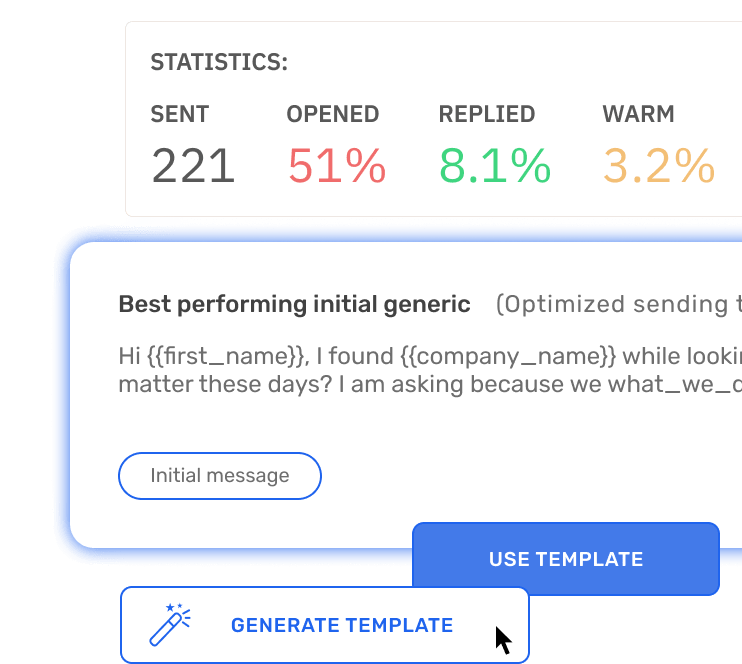TL;DR
- Sales automation increases productivity by automating routine tasks, freeing up sales teams to focus on engaging with prospects and strategic activities.
- It improves lead generation and nurturing by providing consistent, personalized communication with potential customers, which strengthens the sales pipeline.
- Customer retention benefits from CRM systems that allow for personalized interactions and anticipate future customer needs.
- Automated reporting tools offer real-time data and insights, streamlining the decision-making process.
- The onboarding of new sales reps is more efficient with standardized training modules available through automation platforms.
- Enhanced customer experiences through personalization and proactive service contribute to increased loyalty and referrals.
- Sales automation reduces human error in data entry and other sales processes, improving accuracy and compliance.
- Streamlined deal tracking with automation allows for better visibility and management of the sales pipeline.
- A balanced approach to automation is key, ensuring that technology enhances rather than replaces human interactions and judgment.
- The future of sales automation is bright, with the potential for AI to offer even more refined sales tools and analytics.
- Implementing sales automation effectively can give businesses a significant edge in the competitive sales landscape, and testing out Growbots’ trial can be a first step in experiencing these benefits firsthand.
Reach More with Less Effort
Connect with Potential Clients at scale
- AI message generator
- E-mail verification
- Multichannel sequences
- A/B testing
Benefits of Sales Automation
At its core, sales automation refers to the use of software to perform routine sales tasks automatically. The implications of embracing this technology are profound, offering unparalleled benefits. Let’s dig in:Boosted Sales
| Benefit | Description | Impact on Sales |
| Lead Scoring | Automatically prioritizes leads based on likelihood to convert | Increases efficiency in targeting prospects |
| Follow-up Reminders | Ensures timely engagement with leads | Increases likelihood of conversion |
| Email Templates | Speeds up communication with personalized templates | Reduces time spent on manual emailing |
44% of companies who begin utilizing automation software see a return within 6 months.
Source: Kixie.com
Improved Lead Generation
| Feature | Function | Benefit |
| Automated Email Campaigns | Sends targeted emails based on user behavior | Enhances engagement with timely and relevant content |
| Lead Tracking | Monitors lead interactions with the brand | Provides insights to tailor follow-up strategies |
| Dynamic Content | Adapts content within emails based on user data | Increases relevance and engagement with leads |
leave no lead unexplored
Every potential client within reach
- 180m+ contacts
- CRM integrations
- 23 Prospect filters
- 15 Company filters
Customer Retention
Report Creation
| Automated Reporting Feature | Benefit |
| Real-time data access | Allows for prompt decision making |
| Customizable dashlets and dashboards | Provides at-a-glance insights tailored to specific KPIs |
| Scheduled reports | Ensures regular updates without manual intervention |
65% of knowledge workers are less stressed at work because they automate manual tasks.
Source: Zapier.com
Onboarding Sales Reps
| Onboarding Phase | Automation Benefit |
| Training | Standardized, flexible, and scalable training modules |
| Monitoring Progress | Automated tracking of onboarding milestones and KPIs |
| Continual Learning | Access to ongoing educational resources to keep sales skills sharp |
Enhanced Customer Experience
| Customer Interaction Point | Automation Benefit |
| Personalized Communication | Tailors interactions with customers based on their preferences and history |
| Service Ticketing | Automatically addresses customer concerns and routes inquiries for efficient resolution |
| Feedback Collection | Gathers and analyzes customer feedback, leading to continuous improvement |
Post-Sales Customer Journey Optimization
- Regular updates: Automated emails or messages to keep customers informed about their purchases and available resources.
- Feedback solicitation: Surveys and feedback requests sent at strategic times to understand customer satisfaction and areas for improvement.
- Loyalty programs: Implementation and management of loyalty programs that encourage repeat business and referrals.
Time Savings and Efficiency
Sellers in the US and Canada spend over one-third of their time on administrative duties and updating their CRM.
Source: linkedin.com
| Low-Value Task | Time Saved Per Week |
| Data Entry | 5 hours |
| Scheduling | 3 hours |
| Report Generation | 2 hours |
no prior experience & time required
Find your winning outbound formula with Concierge
- 95% activities on our behalf
- Avoid in-house SDR hire
- Learn & Take over anytime
- Numerous A/B tests
Focus on Meaningful Customer Connections
| Customer Connection Benefit | Implication for Sales |
| More Personalized Interactions | Higher conversion rates |
| Deepened Customer Relationships | Increased upsell/cross-sell opportunities |
Consistent Sales Data
| Element | Significance |
| Data Entry Accuracy | Vital for analytics and strategic decisions. |
| Real-Time Updates | Keeps the sales team aligned with the most current information. |
Minimized Errors and Discrepancies
| Type of Error | Description | How Sales Automation Prevents It |
| Data Entry Errors | Mistakes made during manual entry of data | Automates data capture, reducing manual entry |
| Inaccurate Sales Forecasting | Misjudging future sales trends and potentials | Uses historical data and analytics for accuracy |
| Customer Information Errors | Incorrect or outdated customer details | Synchronizes and updates customer databases |
| Lost Sales Opportunities | Failing to follow up or identify prospects | Tracks and manages leads, ensuring timely follow-up |
| Reporting Inconsistencies | Discrepancies in sales reports and analytics | Standardizes reporting formats and data sources |
| Time Management Issues | Inefficient use of time for administrative tasks | Automates routine tasks, freeing time for sales |
| Compliance Issues | Non-adherence to sales policies and regulations | Monitors and ensures compliance with set protocols |
Streamlined Deal Tracking
| Aspect | Benefit |
| Pipeline Visibility | Clear overview of deal statuses |
| Activity Logging | Automatic tracking of all sales interactions |
| Alerts & Notifications | Timely reminders for follow-ups and deadlines |
Automation in Maintaining the Sales Process Flow
| Sales Process Aspect | Automation Impact |
| Task Allocation | Ensures equitable and efficient distribution of tasks among team members |
| Approval Workflows | Speeds up internal processes that might otherwise delay deal progression |
82% of marketers agree that the insights provided by conversation intelligence software could help them reveal blind spots within their sales process and organization.
Source: salesforce.com
Enhanced Lead Qualification Process…
| Lead Qualification Step | Impact of Automation |
| Initial Filtering | Quick identification of viable leads |
| Behavior Analysis | Insight into leads’ likelihood of conversion based on interactions |
| Prospect Nurturing | Automated nurturing campaigns designed to educate and engage leads |
…and Focus on High-Quality Leads
| Automation Feature | Advantage for Sales Teams |
| Lead Scoring | Immediate identification of high-potential prospects |
| Data Analysis | Insights derived from customer data to fine-tune sales approaches |
leave no lead unexplored
Every potential client within reach
- 180m+ contacts
- CRM integrations
- 23 Prospect filters
- 15 Company filters
Disadvantages of Over-Dependence on Automation
While the benefits of sales automation are significant, it is crucial to be aware of the drawbacks associated with an over-reliance on automated systems. When businesses depend too heavily on automation, they may encounter issues such as a lack of personal touch in customer interactions, decreased flexibility for complex sales scenarios, and potential complacency in adapting to evolving market conditions.69% of sales professionals believe that sales pros should use AI/automation tools for prospecting but avoid becoming overly reliant on them.
Source: hubspot.com
| Disadvantage | Description |
| Lack of Personal Touch | Over-reliance on automation can result in customer interactions lacking personalization and human empathy. |
| Decreased Flexibility | Automated systems may struggle to adapt to complex sales scenarios that require nuanced human judgment. |
| Complacency in Market Adaptation | Heavy dependence on automation can lead to sluggishness in adapting to evolving market conditions. |
| Underutilization of Human Expertise | Excessive automation might result in underutilizing the insights and relationship-building skills of sales professionals. |
| Risk of Technology Failure or Limitations | Over-dependence on automation introduces risks associated with technology failures or systemic limitations. |
| Potential for Misaligned Customer Engagement | Automated systems may not fully align with customer needs or expectations, leading to suboptimal engagement. |
| Reduced Creative Problem-Solving | Excessive automation can stifle the creative problem-solving abilities of sales teams. |
Types of Sales Automation Tools
Today’s market offers a plethora of sales automation tools, each designed to optimize different facets of the sales cycle.CRM Software
Customer Relationship Management (CRM) software is at the core of sales automation, encapsulating a broad array of functionalities needed to manage customer interactions, sales tracking, and performance reporting. Using CRM tools can provide sales teams with centralized access to all customer-related data, fostering informed decision-making and a more personal approach to client relations.Here’s a breakdown of how CRM platforms aid sales automation:| CRM Aspect | Function | Sales Impact |
| Lead Management | Organizes and tracks potential customers | Streamlines lead identification and nurturing |
| Sales Forecasting | Predicts future sales and trends | Informs strategic planning and resource allocation |
| Communication Tracking | Logs interactions across channels | Provides a 360-degree view of customer communication |
- HubSpot: Integrates marketing, sales, and service for a full-fledged CRM platform.
- Salesforce: Offers extensive features for sales automation and customer relationship management.
Lead Enrichment Tools
Lead enrichment tools greatly augment the lead generation process by equipping sales teams with detailed and up-to-date information about prospects. These tools automate the collection of data from various sources to create comprehensive profiles, enabling personalized and targeted sales approaches.Consider the following advantages of using lead enrichment tools:| Tool Feature | Sales Benefit |
| Data Accuracy | Provides current and verified information on leads |
| Information Depth | Offers insights into leads’ backgrounds and preferences |
| Automation of Research | Saves time by automatically gathering lead information |
Call and Email Automation Tools
The automation of email and call tasks has revolutionized the sales industry, allowing for high-volume outreach without sacrificing personalization. By leveraging email automation platforms and auto-dialers, sales teams can increase their reach while ensuring that each prospect feels personally addressed.Key benefits of email and call automation are as follows:| Feature | Benefit | Sales Impact |
| Template Customization | Creates personalized messages at scale | Engages prospects with relevant content |
| Auto-dialing Systems | Facilitates high-volume call activities | Enables more touchpoints with prospects |
| Scheduling | Coordinates communication at optimal times | Increases chances of prospect engagement |
Companies that use automated marketing software to send out emails receive twice the number of leads and 58% more conversions than those that send out email blasts.
Source: Moz.com
leave no lead unexplored
Every potential client within reach
- 180m+ contacts
- CRM integrations
- 23 Prospect filters
- 15 Company filters
Implementation Strategies for Sales Automation
Adopting sales automation requires thoughtful planning and execution. The key to a successful implementation lies in identifying areas that stand to benefit the most from automation and integrating these technologies in a manner that complements existing sales processes.Identifying Areas for Automation
The first step is a thorough analysis of current sales operations to determine which tasks are repetitive, time-intensive, but critical for sales success. Priority should be given to automating such tasks to free up valuable time for the sales team.Here’s how you can identify prime candidates for sales automation:- Task Frequency: Frequent tasks are often ideal for automation.
- Time Consumption: Tasks that consume disproportionate time should be automated to increase productivity.
- Error Rate: Tasks prone to human error can often be improved with automation.
Integrating Technology into Sales Processes
The integration of automation technologies should be executed with minimal disruption to the ongoing sales activities. It requires cross-departmental collaboration to ensure the chosen sales automation tools align with broader business goals and systems.Effective integration strategies could include:- Training Programmes: Equip your team with the knowledge to use new tools effectively.
- Pilot Testing: Start small with pilot programs to gauge the impact before full-scale deployment.
- Feedback Loops: Create channels for feedback on the automation tools to optimize and tailor solutions.
Future Prospects of Sales Automation
As the sales landscape continues to evolve, the prospects for sales automation are more promising than ever. Businesses can look forward to more advanced AI-driven tools that refine the precision of sales activities and predictive analytics that offer even deeper insights into customer behavior. The convergence of technology development suggests a future where sales automation is not only ubiquitous but also increasingly intelligent, providing sales professionals with unprecedented advantages.| Future Development | Potential Impact |
| AI and Machine Learning | Greater predictive capabilities and enhanced personalization |
| Integrations and Ecosystems | Seamless connectivity between sales tools and platforms |
| Advanced Analytics | Deeper customer insights and increasingly strategic sales decisions |
Conclusion
Even with the benefits of automation, the human element in sales remains irreplaceable. The balance lies in leveraging technology to handle routine tasks and amplify human efforts to cultivate relationships and provide exceptional customer service. This synergy ensures that automation enhances rather than diminishes the value brought by sales professionals.The ultimate goal is to utilize sales automation in a way that complements human talent, allowing sales reps to showcase their interpersonal skills and build meaningful connections with clients. Businesses that master this blend of technology and personal touch will not only stand out in the market but will also set new benchmarks in customer satisfaction and loyalty.With the outlined strategies and understanding of the benefits of sales automation, organizations are well-equipped to embrace these tools and secure a competitive advantage in the dynamic arena of sales.Our journey through the realm of sales automation is concluded, but the conversation continues. To learn more and explore how automation can transform your sales processes, we encourage you to visit Growbots Blog and access a wealth of resources aimed at driving sales excellence.FAQ
- What is Sales Automation?
- Answer: Sales automation refers to the use of software to automate repetitive and time-consuming tasks in the sales process. This includes activities like email sequencing, lead tracking, updating contact information, scheduling appointments, and generating reports. By automating these tasks, sales teams can focus more on selling and less on administrative work.
- How Does Sales Automation Improve Efficiency?
- Answer: Sales automation streamlines various sales activities, reducing the time spent on manual data entry and task management. It ensures that leads are promptly followed up, information is accurately recorded, and communication is consistent. This improved efficiency can lead to more sales opportunities and faster deal closures.
- Can Sales Automation Help in Lead Qualification?
- Answer: Yes, sales automation tools often include lead scoring and segmentation features. These help in qualifying leads based on their interaction with your business, such as website visits, email engagement, and content downloads. This ensures that sales efforts are focused on leads that are more likely to convert.
- Does Sales Automation Enhance Customer Relationships?
- Answer: Automation tools can contribute to better customer relationships by ensuring timely and personalized communication. Automated emails, reminders, and follow-ups ensure that no customer interaction is missed. This consistency helps in building trust and maintaining strong customer relationships.
- How Does Sales Automation Impact Sales Forecasting?
- Answer: Sales automation provides accurate and up-to-date data that can be used for effective sales forecasting. The ability to track sales activities and outcomes in real-time allows for more accurate predictions about future sales trends and potential revenue.
- Is Sales Automation Cost-Effective?
- Answer: While there’s an initial investment in sales automation software, the long-term benefits often outweigh the costs. By increasing efficiency and productivity, sales automation can lead to more sales and higher revenue, making it a cost-effective solution for many businesses.
- Can Sales Automation Improve Collaboration Among Teams?
- Answer: Yes, sales automation tools often come with features that facilitate better collaboration. This includes shared calendars, document management, and real-time updates which help keep everyone in the loop, fostering a more cohesive working environment.
- Will Sales Automation Replace Human Salespersons?
- Answer: No, sales automation is not about replacing human salespersons but enhancing their capabilities. It automates routine tasks, allowing salespeople to focus more on complex and creative aspects of sales, like strategy and customer relationships.


























